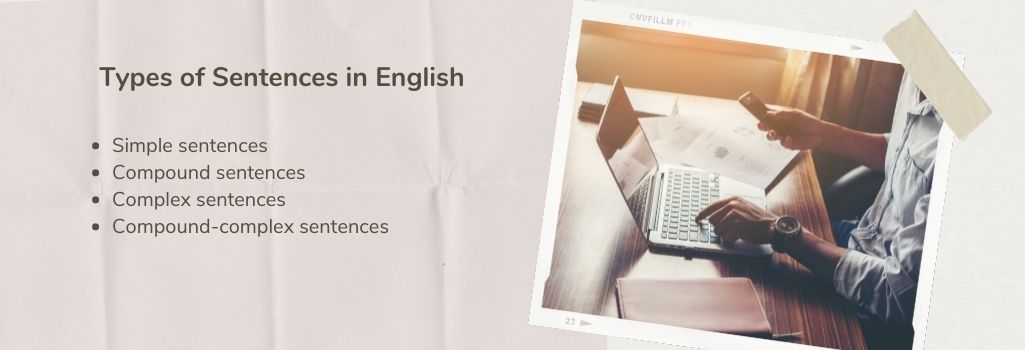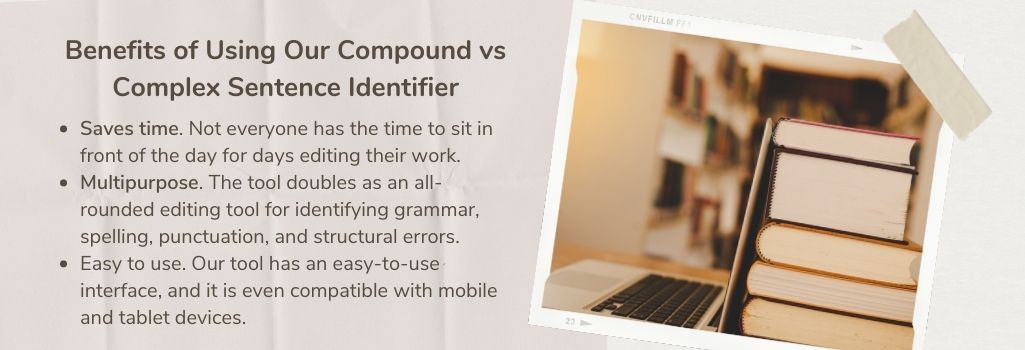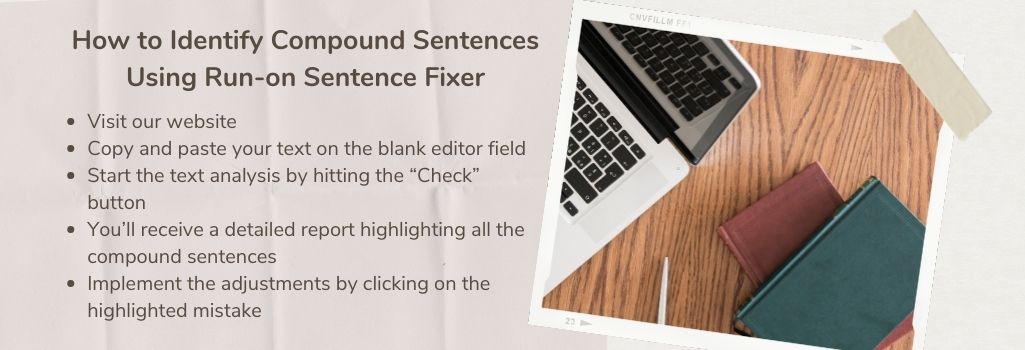A sentence can be defined as the largest unit of any dialect. In English, a sentence begins with a capital letter and ends with either a full-stop, an exclamation mark, or a question mark. According to the Oxford Dictionary, a sentence is a set of words or phrases expressing a complete thought. It typically features a subject and predicate, as well as the main clause and one or more subordinate clauses.
Down the line, sentences can further be profiled into four main categories: simple, compound, complex, and compound-complex sentences. The difference between simple, compound, and complex sentences stems from the number and types of clauses contained in the respective sentence.
If you came here seeking answers on how to tell if a sentence is complex, simple, compound, you have come to the right place. In this article, we are going to give a blow-to-blow account of how to identify compound vs complex sentence, give examples of each, and ultimately reveal how our tool can help.
But before we get ahead of ourselves, there are four major types of sentences in English grammar.

How to Identify a Sentence as Simple Compound Complex or Compound Complex
Wondering how to identify a simple compound and complex sentence? Here are a few tips.
- Simple sentences. A simple sentence contains a subject and a predicate, combining to form a complete thought. It can also contain more than one verb.
For example:
- I always wanted to become a doctor.
- The boy bought a cupcake and took it back to the shop.
- Compound sentences. Here’s how to easily identify a compound sentence: Basically, it is a sentence that joins two or more independent clauses with a coordinating conjunction (e.g., but, and, yet, nor, for, or, so), a conjunctive adverb (e.g., however, rather, furthermore, likewise, therefore), or a semicolon:
For example:
- The boy bought a cupcake, but he took it back to the shop.
- The boy bought a cupcake; however, he took it back to the shop.
- The boy bought a cupcake; he took it back to the shop.
- Complex sentences. Here’s how to tell if a sentence is complex. It contains an independent clause and one or more dependent clauses. The dependent clauses are joined to the independent clause with subordinating conjunctions (e.g., after, when, because) or relative pronouns (that, who, which).
For example:
- After he bought the cupcake, the boy took it back to the shop.
- The boy, who had a bike, felt duped, which is why he took the cupcake back to the shop.
- Compound-complex sentences. Compound-complex sentences contain one or more dependent clauses and one or more independent clauses.
For example:
- When I grow up, I want to be a doctor, and my parents are proud of me.
Compound vs Complex Sentence: Common Mistakes
Now that we have seen how to identify a sentence as complex or compound complex, let’s not look at the common mistakes that writers make. Right off the bat, the easiest way of identifying compound sentences is if they are constructed, as shown in the examples above.
Below are three major errors writers commonly commit when using compound and complex sentences. They include:
- Comma splice
- Fused sentence
- Dangling modifiers
The Comma Splice
This error occurs when two independent clauses in a compound sentence are separated with a comma alone. A comma isn’t necessarily a strong enough punctuation mark to separate two independent clauses in sentences; thus, causing the clauses to be spliced together. This is how you can identify the sentence fragment in your writing and correct it.
For example:
- Spliced: She read the book, her friend watched a movie.
- Correct: She read the book, but her friend watched a movie.
- Correct: She read the book; her friend watched a movie.
- Correct: She read the book; however, her friend watched a movie.
The Fused Sentence
This error occurs when two independent clauses are joined without punctuation between them.
For example:
- Fused: Mary read a novel her friend watched a movie.
- Correct: Mary read a novel, but her friend watched a movie.
- Correct: Mary read a novel; her friend watched a movie.
- Correct: Mary read a novel; however, her friend watched a movie.
Dangling Modifiers
Dangling modifiers mainly occur when a modifier is placed in a manner that could be misconstrued as being associated with a word other than the intended one.
For example:
- Dangling modifier: After taking a shower, the towel needs drying.
- Correct: I need to dry the towel after taking a shower.
If you’ve read this far, chances are you have a basic idea of how to identify a compound sentence or even how to identify a complex sentence without a comma. Unfortunately, mastering all these rules can be exhausting and time-consuming. In many cases, tools such as sentence type identifier will save a lot of your time. This tool helps students and professional writers alike identify the compound sentences in their texts with unmatched speed and accuracy.
For Whom Dangling Modifier Fixer Is Useful?
Our dangling modifier fixer is one of the most versatile online proofreading tools out there, making it ideal for all writing genres. On top of conducting grammatical, spelling, and plagiarism checks, it also covers tone, style, and clarity, making it the ultimate proofreading tool.
In this section, we are going to look at examples of people that can benefit from using and why:
College students. As a student with zero ideas of how to identify compound complex sentences, our tool will crawl through your texts, identify dangling modifiers, and suggest the best possible way to fix the error. It will also help you score better grades by eliminating grammar, spelling, and punctuation errors, which can affect the quality of your academic papers.
Teachers. One of the biggest challenges faced by teachers is providing feedback to students, especially when grading their papers. With the help of our dangling modifier checker, you can simply paste the student’s work on the tool, see all the underlying issues, and then proceed to provide feedback. You can also use the provided plagiarism checker to establish whether the student’s work is 100% original.
Journalists and bloggers. In today’s increasingly digitized world, content is king. If you are a journalist or a content writer looking to achieve higher rankings on search engines, you need to produce high-quality blogs and articles. Luckily, our dangling modifier checker will ensure you have well-written content by eliminating grammar, punctuation, and typos in your writing.
authors and professors: increase the likelihood of publishing your book or scholarly journal article
Professionals. As a business executive, our checker will help generate more leads, boost your earning potential, and reinforce your professional image by getting rid of mistakes in your emails, marketing materials, social media posts, and social media profiles.
Copy editors and proofreaders. Our tool complex sentence identifier can be an equally powerful tool for editors and proofreaders. Unlike manual proofreading which requires you to comb through long manuscripts underlining one mistake after the other, our checker saves you time by automatically flagging multiple mistakes concurrently.
Job seekers. If you are a job seeker, our dangling modifier checker and fixer will help improve your chances of landing an interview by eliminating silly typos and grammar mistakes on your résumé.
Benefits of Using Our Compound vs Complex Sentence Identifier

‘How to find a complex sentence,’ and ‘how to find a compound complex sentence,’ are some of the most searched phrases. And if you are reading this article, chances are you Googled the same. The good news is that using our compound sentence checker does much more than that.
Below are some of the benefits of using our tool:
- Saves time. Editing is a time-intensive affair that requires undivided attention. Unfortunately, not everyone has the time to sit in front of the day for days editing their work. With the help of our tool, you can edit your work and get results instantly.
- Multipurpose. Along with showing you how to identify a compound complex sentence/s, our tool doubles as an all-rounded editing tool for identifying grammar, spelling, punctuation, and structural errors.
- Easy to use. Take a minute and Google the phrase ‘how to identify compound complex sentence,’ and you’ll be bombarded by dozens of scam-like, hard-to-use editing tools. Worse still, some save your work in their local servers, which can lead to unauthorized use. Our compound vs complex sentence checker has an easy-to-use interface, and it is even compatible with mobile and tablet devices.
How to Identify Compound Sentences Using Our Run-on Sentence Fixer

- Visit Our Website.
- Copy and paste your typed text on the blank editor field or type directly on the tool.
- Click the “Check” button to start the analysis.
- Once done, the run-on sentence fixer will give you a detailed report highlighting all the compound sentences, as well as the appropriate suggestions.
- Implement the suggestions by clicking on the highlighted areas.





